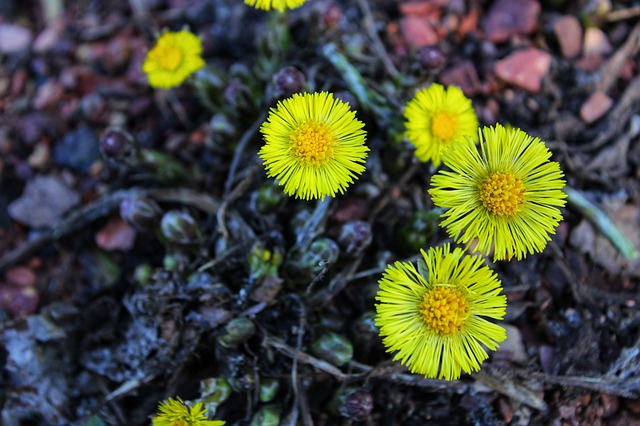Coltsfoot Herb

Also known as Tussilago farfara, Horsehoof, Coughwort, Fieldhove, Bullsfoot, Cleats, Clayweed, Tusilago, and Ass's Foot.
Introduction Coltsfoot grows wild over much of Europe, and has been used traditionally to treat chest ailments for hundreds of years. The name is derived from the horseshoe shaped leaves. It was so popular in Europe at one time that French pharmacists painted its flowers on their doorposts. It was brought to the American colonies from Europe. American colonists were known to wrap persons afflicted with whooping cough in blankets that had been soaked with a coltsfoot infusion. The fleshy leaves, stems and buds are also used in traditional Asian folk medicine to treat asthma, dry cough and bronchitis. Before the plant flowers, it resembles butterbur enough that old herbals caution against confusing the two. At one time, smoking dried coltsfoot leaves was a recommended treatment for coughs, bronchitis and emphysema symptoms. Nowadays, the recommended preparation is a tea. In fact, many herbal practitioners recommend preparing a thermos of coltsfoot tea before bed so that it is ready to be taken first thing in the morning when the coughs due to chronic lung problems are at their worst.
Constituents Mucilage, including numerous sugars; inulin; flavonoids, rutin, isoquercetin, tannin; pyrrolizidine alkaloids.
Parts Used Leaves, and sometimes the buds and flowers.
Typical Preparations Infusion, tea, syrup, capsules and extracts.
Summary Coltsfoot is one of the most widely used herbs for the treatment of coughs and other lung complaints, and is the basis for many of the herbal cough preparations sold in Europe. The chemical constituents have expectorant, anti-tussive, anti-spasmodic, demulcent, anti-catarrhal, and diuretic properties, making coltsfoot extremely helpful in the case of racking coughs such as those that accompany chest colds, asthma and emphysema. However, the USDA classifies coltsfoot as an herb of "unknown safety", and the presence of minute amounts of pyrrolizidine alkaloids, which have been found to cause liver toxicity and cancer, has led to its banning in West Germany. The amount of these alkaloids is extremely small, though, and the beneficial effects are generally believed to outweigh the miniscule risk.
Precautions Coltsfoot should not be used by pregnant women, as it may be an abortifacient, and the alkaloids seem to have a particularly harmful effect on the liver of the developing infant. Pyrrolizidine alkaloids present in the plant are potentially toxic in large doses, but have not proven toxic in the doses usually used to treat coughs. Still, it is recommended that coltsfoot tea or syrup not be used for more than 4-6 weeks at a time.
PURCHASE COLTSFOOT HERB EXTRACT
For educational purposes only. This information has not been evaluated by the Food and Drug Administration. This information is not intended to diagnose, treat, cure, or prevent any disease.
This information courtesy of MOUNTAIN ROSE HERBS, with full, written permission for reuse. For further traditional information concerning Coltsfoot, please visit this excellent resource from Botanical.com. Used with full, written permission.







